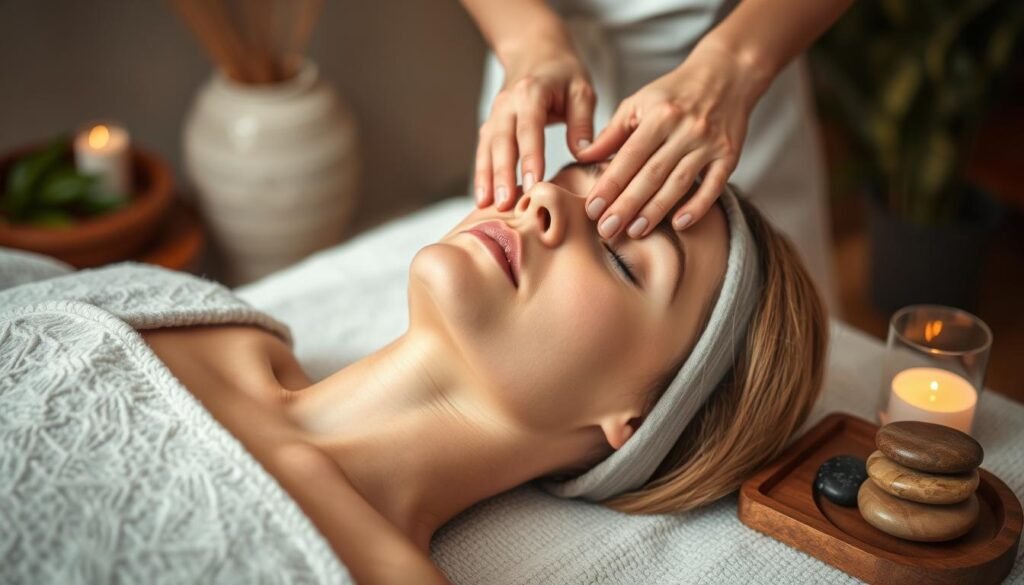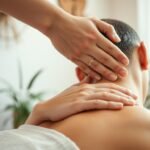Are you tired of jaw pain that won’t go away? You’re not alone. TMJ disorders affect millions, but relief is closer than you think. Learning how to massage TMJ can change your life. Let’s look at simple tmj massage techniques you can do at home to ease your pain and improve your life.
TMJ self-massage is a powerful tool against jaw pain. By applying gentle pressure and using specific movements, you can release tension, boost circulation, and enhance jaw joint mobility. These easy techniques can give you quick relief and, with regular practice, may prevent future pain.
Key Takeaways
- TMJ massage can provide significant relief from jaw pain and discomfort
- Self-massage techniques are easy to learn and can be done at home
- Regular TMJ massage may help prevent future pain episodes
- Proper technique is crucial for effective TMJ self-massage
- Combining massage with other therapies can enhance overall TMJ health
Understanding TMJ Disorders and Their Symptoms
TMJ disorders can really mess up our day, causing pain and discomfort. I’ve been there, and I want to share what I know about TMJ and jaw issues.
What is TMJ and how does it affect the jaw?
The temporomandibular joint (TMJ) links our jaw to our skull. It’s key for speaking, chewing, and yawning. But when it’s off, TMJ disorders can make these simple tasks hard.
Common symptoms of TMJ disorders
TMJ disorders show up in different ways. Here are some common signs:
- Jaw pain or tenderness
- Facial pain
- Difficulty opening or closing the mouth
- Clicking or popping sounds when moving the jaw
- Headaches
- Earaches
Causes of TMJ pain and discomfort
Knowing what causes TMJ pain is key for relief. I’ve found a few main reasons:
| Cause | Description |
|---|---|
| Stress | Can lead to teeth clenching and jaw tension |
| Teeth grinding | Puts excessive pressure on the jaw joint |
| Tooth misalignment | Creates an imbalance in jaw mechanics |
| Arthritis | Causes inflammation in the joint |
| Jaw injury | Can damage the joint or surrounding tissues |
Knowing these symptoms and causes helps us find better ways to manage TMJ pain. Next, I’ll talk about how TMJ massage can help.
The Benefits of TMJ Massage for Pain Relief

TMJ massage therapy helps those with jaw tension and pain. Regular massages can greatly improve jaw function and lessen pain from temporomandibular joint disorders.
One big plus of tmj massage for jaw tension is muscle tension release. Massage targets specific jaw areas, relaxing tense muscles. This gives quick relief from pain and stiffness.
Another benefit is better blood circulation. Massage boosts blood flow to the affected area, aiding healing and reducing swelling. This can also help with headaches linked to TMJ disorders.
TMJ massage also improves joint mobility. Regular sessions can make it easier to eat and speak by increasing jaw range of motion.
| Benefit | Description |
|---|---|
| Pain Reduction | Decreases jaw discomfort and associated headaches |
| Muscle Relaxation | Releases tension in jaw muscles |
| Improved Circulation | Enhances blood flow to promote healing |
| Better Mobility | Increases range of motion in the jaw joint |
TMJ massage therapy is especially helpful when other treatments don’t work. I’ve seen it provide relief when painkillers and bite guards didn’t. Massage targets specific muscles causing jaw pain, offering a focused pain management approach.
Preparing for Your TMJ Self-Massage Session
Before starting tmj self-massage, it’s key to prepare well. I’ll show you how to get ready for your tmj massage. This will help you relieve pain effectively.
Creating a relaxing environment
First, find a quiet place where you won’t be bothered. Dim the lights and play soft music. This creates a calm atmosphere, helping your body and mind relax.
Proper hand hygiene and positioning
Wash your hands well with soap and warm water. Trim your nails to avoid scratching your skin. Sit or lie down comfortably, as you prefer.
Understanding pressure levels and sensitivity
When learning tmj massage, start with gentle pressure. Begin with light touches and slowly increase pressure. If you feel pain, stop right away. The goal is to relax your muscles, not cause pain.
Take a few deep breaths before starting. This helps you focus and relax, making your massage more effective. Remember, work with your body, not against it.
“The art of massage is in the gentleness of touch and the mindfulness of pressure.”
By following these steps, you’re ready for a successful tmj self-massage. With practice, you’ll find the right pressure and technique to ease your TMJ pain.
How to Massage TMJ: Step-by-Step Techniques

Learning tmj massage techniques can help with jaw pain and discomfort. I’ll show you how to massage tmj, focusing on muscles linked to TMJ disorders.
Masseter Muscle Massage
The masseter is a strong jaw muscle that can cause TMJ pain. To massage it:
- Find the muscle by clenching your teeth and feeling your cheek
- Use your fingertips to apply gentle pressure
- Move in small circles from your cheekbone down to your jawline
- Repeat for 30 seconds on each side
Temporalis Muscle Massage
The temporalis muscle is on the side of your head and can lead to tension headaches. To relieve it:
- Place your fingertips on your temples
- Apply gentle pressure and move in circular motions
- Gradually work your way up to the top of your head
- Continue for 1-2 minutes on each side
Lateral Pterygoid Muscle Massage
This muscle is inside your mouth and can be hard to reach. Here’s how to massage it:
- Open your mouth slightly
- Place your thumb inside your cheek, near your back teeth
- Gently press and move in small circles
- Hold for 5-10 seconds, then release
Intraoral Massage Techniques
Intraoral massage targets deeper muscles. Use a clean, gloved finger:
- Insert your finger between your cheek and teeth
- Gently massage the inner cheek area
- Move along the upper and lower jaw
- Spend about 30 seconds on each side
| Muscle | Technique | Duration |
|---|---|---|
| Masseter | Circular motions | 30 seconds per side |
| Temporalis | Gentle pressure, circular motions | 1-2 minutes per side |
| Lateral Pterygoid | Small circles inside cheek | 5-10 seconds hold |
| Intraoral | Gentle massage inside cheek | 30 seconds per side |
Additional TMJ Relief Exercises

Adding TMJ massage to specific exercises can help with jaw clicking and lockjaw. These easy movements fit into your daily life. They help your tmj massage for clicking jaw work better.
Begin with jaw opening and closing. Slowly open your mouth, hold for a few seconds, then close it. This boosts jaw movement and lessens stiffness. Next, do chin tucks by pulling your chin back while keeping your neck straight. This targets the jaw area muscles.
If you have lockjaw, try tongue-to-roof exercises. Press your tongue against the roof of your mouth and hold for 5-10 seconds. This relaxes jaw muscles and is great for tmj massage for lockjaw.
Controlled side-to-side jaw movements are also helpful. Gently move your jaw from left to right, holding each side for a few seconds. This improves jaw flexibility and reduces tension.
- Jaw opening and closing: 10 repetitions
- Chin tucks: 5-10 repetitions
- Tongue-to-roof exercise: Hold for 5-10 seconds, repeat 5 times
- Side-to-side jaw movements: 5 repetitions on each side
Do these exercises gently and stop if you feel pain or discomfort. Combining these exercises with TMJ massage can help relieve jaw pain and improve jaw function.
Incorporating Heat and Cold Therapy with TMJ Massage
Using heat and cold therapy with tmj pain relief massage can make it more effective. This method is especially good for tmj massage for headaches. Let’s look at when to use each and how to switch them for the best results.
When to use heat therapy
Heat therapy is great before a TMJ massage. It relaxes muscles and boosts blood flow. I warm my jaw with a compress for 10-15 minutes before massaging. This makes the massage more effective and comfortable.
When to use cold therapy
Cold therapy is best after a massage or during sharp pain. It cuts down inflammation and numbs pain. I use an ice pack wrapped in a towel for about 10 minutes. This eases any soreness after the massage and calms irritated tissues.
Alternating heat and cold for optimal relief
For persistent TMJ pain, I switch between heat and cold. This method, called contrast therapy, offers better relief. I start with heat for 3-5 minutes, then cold for 1 minute. Doing this cycle 3-5 times often brings a lot of comfort.
- Always wrap hot or cold packs in a towel to protect your skin
- Limit each therapy session to 15-20 minutes
- Wait at least an hour between sessions
By mixing these heat and cold therapies with tmj pain relief massage, I’ve seen better and longer-lasting relief from TMJ pain.
Lifestyle Changes to Support TMJ Health
Living with TMJ disorder can be tough, but simple lifestyle changes can help a lot. I’ve found that adding tmj massage for jaw tension to these changes works best.
Reducing stress is key. I do deep breathing and meditation every day to relax my jaw. Yoga has also helped a lot, releasing tension in my body, including my jaw.
It’s important to avoid habits that strain the jaw. I’ve stopped chewing gum and biting my nails. These changes have really helped my TMJ symptoms.
Good posture is also crucial. I sit up straight and keep my computer screen at eye level to avoid neck and jaw strain. This goes well with my tmj disorder massage routine.
Changing what I eat can also help. I’ve added more anti-inflammatory foods to my diet, like:
- Fatty fish
- Berries
- Leafy greens
- Nuts and seeds
These foods help with joint health and reduce inflammation, which is good for TMJ disorders.
| Lifestyle Change | Benefit for TMJ Health |
|---|---|
| Stress reduction techniques | Relaxes jaw muscles |
| Avoiding jaw-straining habits | Reduces unnecessary tension |
| Maintaining good posture | Alleviates neck and jaw strain |
| Anti-inflammatory diet | Supports joint health |
By making these lifestyle changes and getting regular tmj massage for jaw tension, I’ve seen big improvements in my TMJ symptoms. It’s a complete approach that tackles the main causes of TMJ discomfort.
When to Seek Professional Help for TMJ Pain
TMJ massage therapy works for many, but sometimes you need a pro. Knowing when to get expert help is key to managing TMJ pain well.
Signs That Indicate the Need for Medical Intervention
If tmj pain relief massage doesn’t work for you, it’s time to see a doctor. Look out for these warning signs:
- Chronic jaw pain lasting more than a few weeks
- Difficulty opening or closing your mouth
- Noticeable changes in your bite alignment
- Clicking or popping sounds when moving your jaw
- Frequent headaches or earaches
Types of Professionals Who Treat TMJ Disorders
Many specialists offer advanced tmj massage therapy and treatments. Here’s a list of experts who can help:
| Professional | Expertise | Treatment Approach |
|---|---|---|
| TMJ Dentist | Jaw alignment, bite issues | Dental appliances, bite adjustments |
| Physical Therapist | Muscle and joint function | Exercises, manual therapy |
| Chiropractor | Spinal and jaw alignment | Adjustments, soft tissue work |
| Oral Surgeon | Complex jaw issues | Surgical interventions |
Getting professional help doesn’t mean you’ve failed at self-care. These experts can add personalized tmj pain relief massage to their treatments. This ensures you get the best care for your TMJ disorder.
Complementary Therapies for TMJ Pain Management
Managing TMJ pain requires a mix of approaches. Besides tmj massage for headaches and exercises, other therapies can help. Acupuncture, for instance, has helped many people with TMJ pain.
Biofeedback and cognitive behavioral therapy are great for managing stress and tension. These mind-body techniques help us control our body’s responses. They’re especially useful for tmj massage for clicking jaw symptoms.
Custom-fitted mouthguards or splints can protect and align the jaw. Ultrasound therapy uses sound waves to lessen pain and improve jaw movement. Always talk to a healthcare professional before trying new treatments to make sure they’re right for you.
FAQ
What is TMJ and how does it affect the jaw?
What are the common symptoms of TMJ disorders?
What are the benefits of TMJ massage for pain relief?
How can I create a relaxing environment for TMJ self-massage?
What are some step-by-step techniques for TMJ self-massage?
What additional exercises can help with TMJ relief?
When should I use heat therapy for TMJ pain?
When should I use cold therapy for TMJ pain?
What lifestyle changes can support TMJ health?
What signs indicate the need for professional help for TMJ pain?
What complementary therapies can help with TMJ pain management?
Source Links
- Stubborn TMJ Pain? Try Trigger Point Massage and Jaw Exercises – https://health.clevelandclinic.org/stubborn-tmj-pain-try-trigger-point-massage-and-jaw-exercises
- How To: TMJ Massage – Self Massage Techniques for Lasting Jaw Pain Relief — Alyssa Coulter, LMT | Massage Therapy in Knoxville, Tennessee – https://www.coultermassage.com/blog/4-self-massage-techniques-for-tmj-disorders-a-guide-to-at-home-jaw-relief
- Relieving TMJ Pain: A Guide for TMJ Massages and Exercises – https://www.gatewaysleepandtmj.com/blog/relieving-tmj-pain-a-guide-for-tmj-massages-and-exercises/













3 Comments
Interesting article! But, can TMJ massages really relieve pain without professional guidance? Isnt self-treatment risky?
Interesting read! But how does one distinguish TMJ pain from other common jaw discomforts? Any specific symptoms to look out for?
Interesting read! Has anyone tried these TMJ massages and experienced any side effects? Im a bit apprehensive about self-treatment.